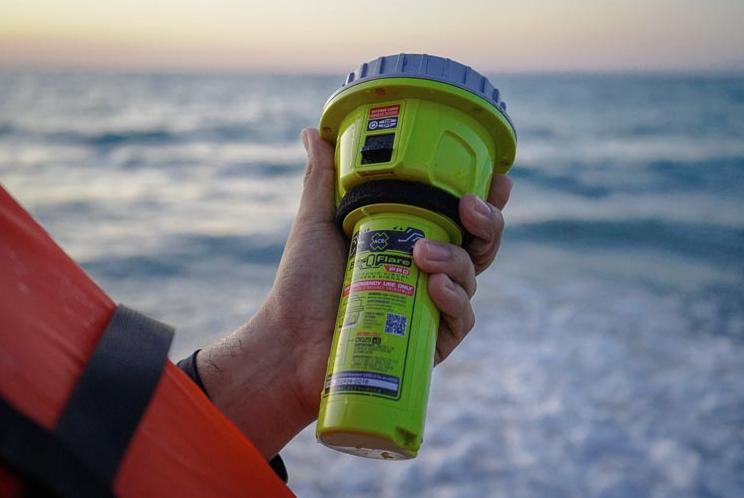Starting in 2026, the U.S. Coast Guard is expected to broaden its recognition of electronic visual distress signals (eVDSDs), including a wider range of LED flares that meet updated technical and visibility standards. This change marks a significant shift away from traditional pyrotechnic flares — which have been the standard for decades — toward safer, longer-lasting, and more environmentally friendly alternatives.
Let’s break down what these upcoming changes mean for recreational boaters, particularly those navigating U.S. waters or crossing into them from Canada.
Current Regulations (as of 2025)
At present, the USCG allows electronic visual distress signals (eVDSDs) as legal alternatives to traditional pyrotechnic flares only under specific conditions. According to current rules:
- An approved LED flare must meet USCG standard 46 CFR 161.013.
- It must be paired with a day signal, typically an orange distress flag.
- Only certain brands/models (like Orion’s SOS Distress Light) are certified.
These eVDSDs are valid for night use only and are typically battery-powered devices that flash the international SOS signal in white or red LED light.
What’s Changing in 2026
The U.S. Coast Guard has announced its intention to expand and update its eVDSD requirements and acceptance standards in 2026, likely by:
- Allowing standalone LED distress devices without needing to pair them with a separate day signal.
- Widening the field of approved devices, potentially recognizing more manufacturers and models.
- Updating visibility requirements, including:
- Flash patterns visible for at least 10 nautical miles at night.
- Minimum 360-degree visibility (horizontal and/or vertical).
- Extended battery life standards (typically at least 2 hours continuous use).
- Including multi-colored LED distress patterns, such as combinations of red and infrared for man-overboard or rescue beacons.
The updates are aimed at modernizing outdated pyrotechnic requirements, improving boater safety, reducing environmental waste, and simplifying flare maintenance.
Why the Shift to LED Flares?
There are several reasons behind the push to make LED flares more mainstream and eventually phase out pyrotechnic-only mandates:
✅ Safety
- No risk of burns or accidental ignition.
- No toxic smoke or handling hazards.
✅ Longevity
- LED eVDSDs can last for years with battery replacements.
- No expiration every 3–4 years like traditional flares.
✅ Eco-Friendly
- No chemical pollutants entering the water or air.
- No disposal concerns with expired devices.
✅ Usability
- Simple push-button operation.
- Visible from a distance with no flame or heat.
What Will Still Be Required?
While these rule changes are intended to simplify the use of LED flares, the USCG is likely to retain performance-based certification under new revised standards that may be codified under new CFR designations or updates to existing ones.
As with current eVDSDs, you should expect:
- A visible SOS signal pattern.
- A Coast Guard approval label.
- Compliance with battery duration and light intensity regulations.
Boaters will likely still need to carry at least three approved nighttime signals, whether pyrotechnic or electronic, for vessels operating in U.S. coastal waters, the Great Lakes, or high seas.
Canadian Boaters Entering U.S. Waters
For boaters visiting from Canada — including popular destinations like Lake St. Clair, the St. Lawrence River, or Lake Ontario — this rule update could simplify cross-border compliance:
- No need to carry expired flares just to meet U.S. entry requirements.
- Easier inspection compliance during CBP ROAM trips or U.S. boarding.
- Better integration with Transport Canada’s evolving stance on electronic distress signals (still developing).
Note: While Transport Canada currently does not yet accept eVDSDs in place of pyrotechnics, the 2026 USCG change could influence Canadian standards in years to come.
Which LED Flares Might Become Approved?
While official 2026 standards are still being finalized, some likely candidates already being tested or marketed include:
- Orion Safety Products – SOS Distress Light Gen II
- ACR Electronics – ResQFlare and C-Light H2O
- Weems & Plath – C-1001 SOS Beacon
- Sirius Signal – C-1003 and newer models
Manufacturers will need to submit their devices for USCG testing and certification under the new requirements once the 2026 standards are finalized and published in the Federal Register.
When Will This Take Effect?
The expected implementation date is mid-to-late 2026, but here’s what to keep in mind:
- A proposed rulemaking and comment period will likely occur in early 2026.
- Boat safety equipment manufacturers are preparing for compliance testing.
- Enforcement may begin gradually, with a transition grace period for replacing older devices.
We’ll update Vessel Star readers as soon as the final rule is published.
Summary
| Feature | Pyrotechnic Flares | LED Flares (2026+) |
|---|---|---|
| Burn time | ~30–60 seconds | 2+ hours continuous |
| Expiry | 42 months | 5–10 years (battery dependent) |
| Safe for kids | ❌ No | ✅ Yes |
| Visible from air | ✅ Yes | ✅ Yes |
| Disposal needed | ✅ Yes | ❌ No |
| Approved for day/night use | ✅ Yes | ✅ (new models only) |
Final Thoughts
The 2026 changes coming from the U.S. Coast Guard regarding LED flare acceptance signal a big step forward in marine safety modernization. It’ll mean fewer flare replacements, safer onboard storage, and a cleaner environmental footprint — all while still keeping boaters visible and safe on the water.
If you’re thinking about upgrading your flares, wait until the 2026 models are USCG-approved under the new regulations. That way, you’ll be future-proofed for both safety and compliance.
Stay tuned to Vessel Star for the latest rule updates and gear reviews as the 2026 deadline approaches.

Use the share button below if you liked it.